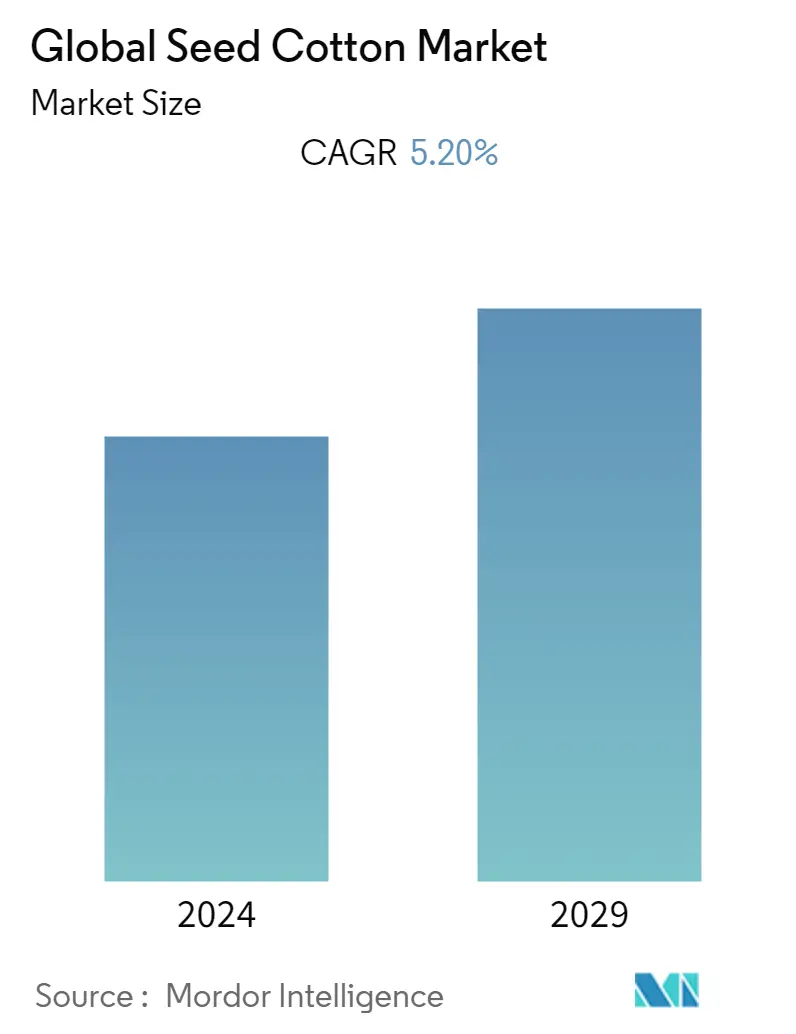Market Size of Global Seed Cotton Industry

| Study Period | 2019 - 2029 |
| Base Year For Estimation | 2023 |
| Forecast Data Period | 2024 - 2029 |
| CAGR | 5.20 % |
| Fastest Growing Market | Asia-Pacific |
| Largest Market | Asia-Pacific |
Major Players*Disclaimer: Major Players sorted in no particular order |
Seed Cotton Market Analysis
The global seed cotton market is anticipated to register a CAGR of 5.2% over the forecast period. Cottonseed and cotton lint together constitute the seed cotton. Owing to the fluctuation in the prices of Bt Cotton, cotton seed companies halt the supplies. For example, cotton seed companies in India protested against the Government's plan to cut down prices by 7.5%.
Seed Cotton Industry Segmentation
Cotton is a crop that is majorly used in textile industries. It is a perennial crop that is harvested in moderate rainfall and during a frost-free period with plenty of sunshine. It is somewhat salt- and drought-tolerant, which makes it an attractive crop for the arid and semi-arid regions. However, the major problem with the cotton crop is its pest control, extensive farming, and labor requirement.
| North America | |||||||
| |||||||
|
| Europe | |||||||
| |||||||
|
| Asia- Pacific | |||||||
| |||||||
| |||||||
| |||||||
|
| Africa | |||||||
| |||||||
| |||||||
|
Global Seed Cotton Market Size Summary
The global cotton seed market is poised for steady growth, driven by a compound annual growth rate over the forecast period. This market encompasses both cottonseed and cotton lint, which together form the seed cotton. The industry faces challenges such as price fluctuations in Bt Cotton, leading to supply disruptions by cotton seed companies. A significant development in the sector is the removal of the no-objection certificate requirement by the Protection of Plant Varieties and Farmers' Rights authority, which previously restricted small and medium-sized companies from accessing technology to develop new cotton seed varieties. This regulatory change is expected to foster innovation and growth among these companies, enabling them to create hybrid cotton seed varieties.
China and India dominate the seed cotton production landscape, with both countries being the largest producers globally. India, in particular, holds a significant share of the Asia-Pacific market and is a leading producer and exporter of cotton. To maintain its competitive edge, India is focusing on enhancing productivity through innovative seed treatment methods. The market dynamics in these regions underscore the importance of technological advancements and regulatory support in sustaining growth and addressing challenges in the cotton seed industry.
Global Seed Cotton Market Size - Table of Contents
-
1. MARKET DYNAMICS
-
1.1 Market Overview
-
1.2 Market Drivers
-
1.3 Market Restraints
-
1.4 Value Chain / Supply Chain Analysis
-
-
2. MARKET SEGMENTATION
-
2.1 North America
-
2.1.1 United States
-
2.1.1.1 Production Analysis
-
2.1.1.2 Consumption Analysis
-
2.1.1.3 Import Market Analysis (Volume and Value)
-
2.1.1.4 Export Market Analysis (Volume and Value)
-
2.1.1.5 Price Trend Analysis
-
-
2.1.2 Mexico
-
2.1.2.1 Production Analysis
-
2.1.2.2 Consumption Analysis
-
2.1.2.3 Import Market Analysis (Volume and Value)
-
2.1.2.4 Export Market Analysis (Volume and Value)
-
2.1.2.5 Price Trend Analysis
-
-
-
2.2 Europe
-
2.2.1 Spain
-
2.2.1.1 Production Analysis
-
2.2.1.2 Consumption Analysis
-
2.2.1.3 Import Market Analysis (Volume and Value)
-
2.2.1.4 Export Market Analysis (Volume and Value)
-
2.2.1.5 Price Trend Analysis
-
-
2.2.2 Greece
-
2.2.2.1 Production Analysis
-
2.2.2.2 Consumption Analysis
-
2.2.2.3 Import Market Analysis (Volume and Value)
-
2.2.2.4 Export Market Analysis (Volume and Value)
-
2.2.2.5 Price Trend Analysis
-
-
-
2.3 Asia- Pacific
-
2.3.1 India
-
2.3.1.1 Production Analysis
-
2.3.1.2 Consumption Analysis
-
2.3.1.3 Import Market Analysis (Volume and Value)
-
2.3.1.4 Export Market Analysis (Volume and Value)
-
2.3.1.5 Price Trend Analysis
-
-
2.3.2 China
-
2.3.2.1 Production Analysis
-
2.3.2.2 Consumption Analysis
-
2.3.2.3 Import Market Analysis (Volume and Value)
-
2.3.2.4 Export Market Analysis (Volume and Value)
-
2.3.2.5 Price Trend Analysis
-
-
2.3.3 Pakistan
-
2.3.3.1 Production Analysis
-
2.3.3.2 Consumption Analysis
-
2.3.3.3 Import Market Analysis (Volume and Value)
-
2.3.3.4 Export Market Analysis (Volume and Value)
-
2.3.3.5 Price Trend Analysis
-
-
2.3.4 Turkey
-
2.3.4.1 Production Analysis
-
2.3.4.2 Consumption Analysis
-
2.3.4.3 Import Market Analysis (Volume and Value)
-
2.3.4.4 Export Market Analysis (Volume and Value)
-
2.3.4.5 Price Trend Analysis
-
-
-
2.4 Africa
-
2.4.1 Egypt
-
2.4.1.1 Production Analysis
-
2.4.1.2 Consumption Analysis
-
2.4.1.3 Import Market Analysis (Volume and Value)
-
2.4.1.4 Export Market Analysis (Volume and Value)
-
2.4.1.5 Price Trend Analysis
-
-
2.4.2 Nigeria
-
2.4.2.1 Production Analysis
-
2.4.2.2 Consumption Analysis
-
2.4.2.3 Import Market Analysis (Volume and Value)
-
2.4.2.4 Export Market Analysis (Volume and Value)
-
2.4.2.5 Price Trend Analysis
-
-
2.4.3 South Africa
-
2.4.3.1 Production Analysis
-
2.4.3.2 Consumption Analysis
-
2.4.3.3 Import Market Analysis (Volume and Value)
-
2.4.3.4 Export Market Analysis (Volume and Value)
-
2.4.3.5 Price Trend Analysis
-
-
-
Global Seed Cotton Market Size FAQs
What is the current Global Seed Cotton Market size?
The Global Seed Cotton Market is projected to register a CAGR of 5.20% during the forecast period (2024-2029)
Which is the fastest growing region in Global Seed Cotton Market?
Asia-Pacific is estimated to grow at the highest CAGR over the forecast period (2024-2029).

